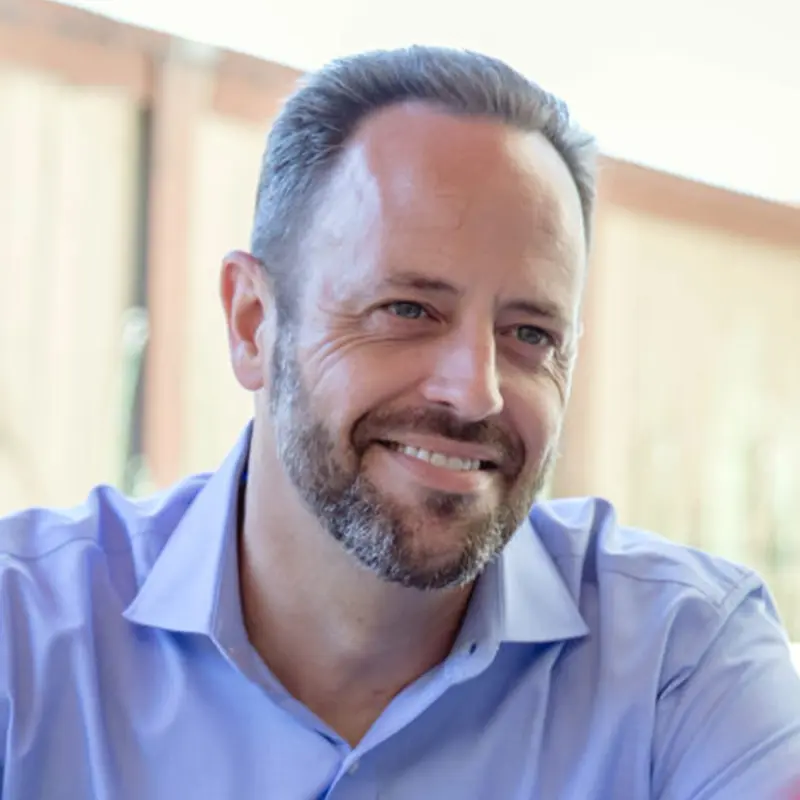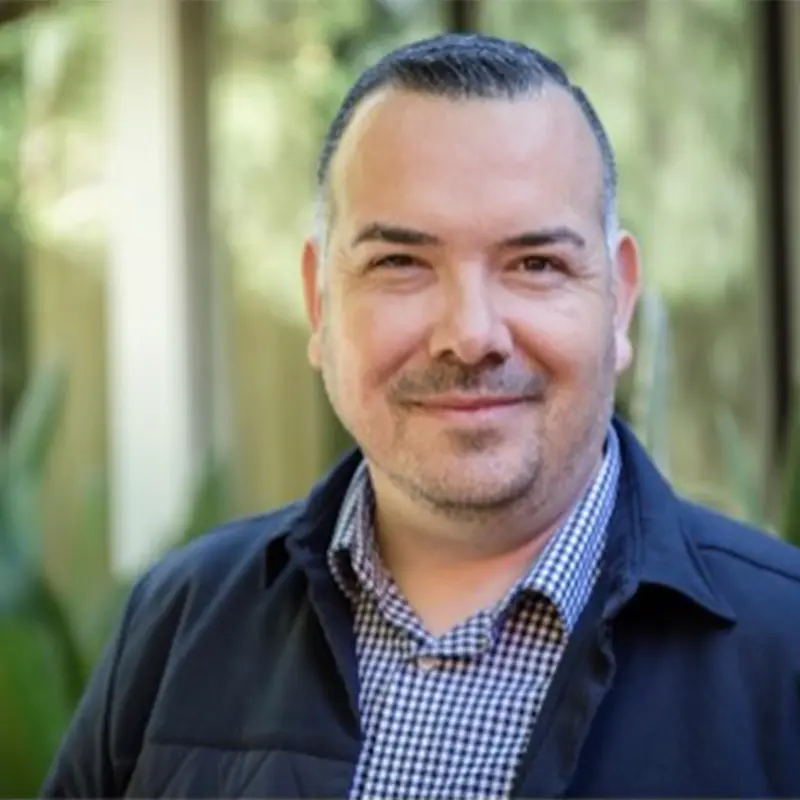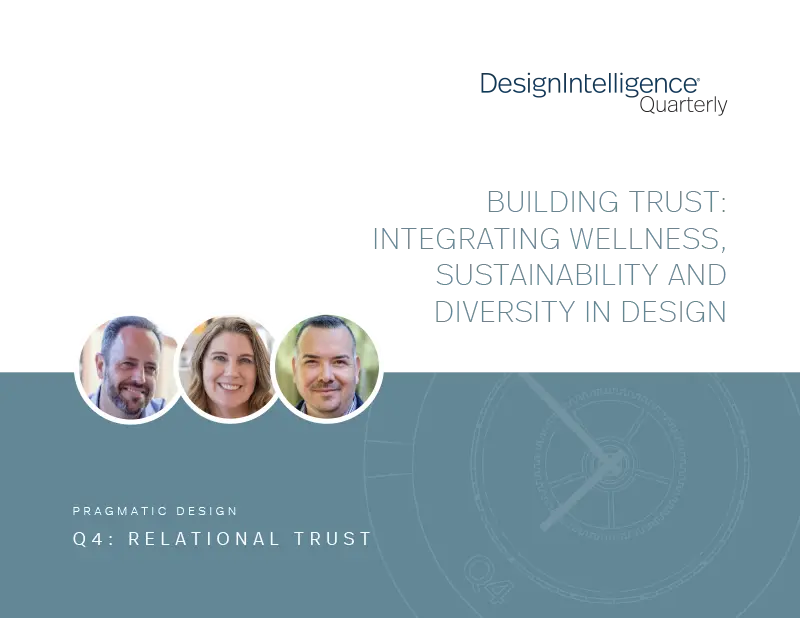Building Trust: Integrating Wellness, Sustainability and Diversity in Design
by James Krueger, AIA, NCARB
Director of Design, HMC Architects
Jennifer Wehling, AIA, LEED AP BD+C, LEED AP ID+C, WELL AP
Director of Sustainability, HMC Architects
& Sergio A. Lechuga, CID
Director of Interior Design, HMC Architects
October 4, 2023
Three HMC leaders share secrets to synergy.
Beyond Minimum
In the evolving landscape of architecture and design, professionals are no longer focused only on meeting the minimum expectations of clients and stakeholders. Today’s design leaders are confronted with broader considerations, including wellness, sustainability, diversity, equity and value. Beyond mere add-ons, these aspects are integral components of good design and should be seamlessly incorporated into every level of the design process. Achieving a harmonious balance among economic, social and environmental issues while accounting for budget, scope, schedule and project-specific factors is the key to successful project outcomes. Embracing such a multifaceted balancing act while pushing boundaries can create projects that minimize environmental impact and enhance the human experience. But how?
First Things First
No attempt to do so can begin without first prioritizing goals and building trust. These two actions form the foundation for integrating wellness, sustainability and diversity into the design process. Architects can create meaningful, sustainable and inclusive spaces that cater to end-user needs by aligning client objectives, employing strategic design frameworks and involving diverse voices. Still, before they can start, they need to have common goals — and trust one another.
Traditionally, architects have been tasked with balancing economic, social and environmental concerns. While this remains crucial, today’s design leaders face a more comprehensive balancing act that encompasses additional dimensions. Including wellness, sustainability, diversity, equity and inclusion in design is no longer optional; it is imperative. These aspects have become expected for those trying to create spaces that meet occupants’ needs, respect environmental considerations and reflect the diverse communities they serve.
Seeking Synergy
To achieve successful projects, design leaders must extend their focus beyond the fundamental economic, social and environmental factors. They must also account for project-specific elements such as budget, scope, schedule, client priorities, local opportunities and the project team’s expertise. By holistically incorporating such considerations into their design processes, architects can create synergy — and find the sweet spot where these factors converge to maximize positive outcomes.
Listening Frameworks
Each project requires a tailored approach to balance priorities effectively. As designers, we gain insights into client goals, needs and preferences by engaging them in extensive discussions. This process involves collaborative goal-setting and establishing priorities, differentiating between “need to haves” and “like to haves.” To guide these discussions, we employ frameworks for design excellence that help us listen.
Sustainability Mindsets
Because sustainability is good design, we embrace having a sustainability mindset at the core of the design process. While design excellence frameworks may address sustainability explicitly or implicitly, they encompass principles that align with sustainable practices. When we begin design with sustainability in mind, we add clarity to project goals. We inform project strategies. Beyond first-wave environmental aspects, we include social and economic sustainability by helping our clients understand that their building looks the way it does because it performs the way it does.
In our version of building trust, we strive to include diverse voices in the design process. This extends beyond traditional stakeholders and includes underrepresented groups, Indigenous cultures and individuals whose perspectives often go unheard. We recognize the importance of justice, equity, diversity and inclusion (JEDI) principles and create an inclusive environment where all stakeholders have a voice. Having a diverse group of people within our firm is where that begins. To serve every human being individually and entirely, design firms need people that reflect the diversity of our communities. Leveraging that diversity creates better designs.

Making Choices: Tools Required
As designers, we have the lead in integrating sustainability and performance into design decisions. While our clients may be aware of sustainability concepts and potential, we are responsible for guiding them toward the best decisions based on data and performance. This includes selecting materials and systems that align with project goals.
To cope with an ever-growing array of choices and information, we employ project management tools to help clients make decisions. These tools, such as option summaries and our live “choosing by advantage” sessions, help clients visualize options, return on investment and performance data. They enable collaborative decision-making, but the recipe for synergy demands more than simple tools. Interaction and trust are the secret ingredients of consensus and better outcomes.
Getting Together: Trust Required
To understand why, consider this recent HMC project case study. On a recent design-build project we conducted a “choosing by advantage” session in a “big room meeting” with all stakeholders involved. We made decisions in real time and graded them based on effectiveness. We “chose by advantage” and scored each decision together. As a result of this live, collaborative process and having shared common goals, our decisions stuck, and the project got built. We were not only efficient, but we also trusted one another. Though we try it on all projects, in some instances we can only get some of the constituents to join us in the big room. That’s where a different kind of trust enters: Those who can’t join us live rely upon their trust relationships with us as we represent them and report on the outcomes.
These kinds of processes don’t just encourage collaboration, they require it. Involving and including the voices and perspectives of many allows — and demands — the creation of inclusive, representative designs. In contrast to the architect-dictated days of old, such approaches foster a sense of ownership for clients that makes the designs their own. Through collaborative, inclusive design, we can deliver buildings that don’t just meet the client’s objectives, they positively impact the users’ lives.
Making a Difference
The spaces we create make a difference. We need to consider that when designing these spaces and engaging with diverse populations. To achieve that, our teams work closely together. We respect one another, and we work toward the greater good. There is something unique within this set of constructs, something that we value. We call it relational trust. We have to nurture it within our teams internally before we can build it with our clients and partners.
Relational trust is the foundation for integrating wellness, sustainability and diversity into architectural design. Designers can balance economic, social and environmental factors by understanding client goals, employing strategic frameworks and involving diverse voices. This holistic approach — people and process, tools and trust — ensures sustainable, high-performing designs that promote inclusivity, wellness and a sense of client ownership.
By building and fostering relational trust, we can create meaningful and impactful spaces that contribute positively to the built environment and society.
Jennifer Wehling, AIA, LEED AP BD+C, LEED AP ID+C, WELL AP
Director of Sustainability, HMC Architects
With over 20 years of experience as an architect and a passion for the environment, Jennifer has a unique outlook on the challenges and opportunities that every project faces. She works with project teams to integrate sustainability into the design process while respecting the budget, scope and schedule constraints inherent in all projects. As director of sustainability at HMC, Jennifer takes a holistic approach to sustainability in the firm’s design work and operations, guiding HMC in minimizing its footprint while maximizing its positive impact.
Sergio A. Lechuga, CID
Director of Interior Design, HMC Architects
Sergio is HMC’s director of interior design. With over 15 years of experience in project management and design spanning health care, education and civic environments, Sergio strives for beautiful interiors that are pragmatic and functional while being contextual and evocative of the client, their values, and the community in which they serve. Sergio also received a Master of Architecture in Real Estate Development.
James Krueger, AIA, NCARB
Director of Design, HMC Architects
As HMC’s director of design, James plays a pivotal role in overseeing and strategizing ways to enhance the impact of HMC’s work. With an impressive 22-year track record in designing facilities that make a positive difference in the communities they serve, James brings a wealth of experience to HMC clients. Previously serving as design principal, he has successfully led numerous projects in HMC’s PreK-12 and Community + Culture practices. James’s creative approach is deeply rooted in HMC’s mission of design for good, and he is committed to providing clients with high-performance solutions that create a meaningful and positive impact.

 James Krueger
James Krueger
 Jennifer Wehling
Jennifer Wehling
 Sergio A. Lechuga
Sergio A. Lechuga
